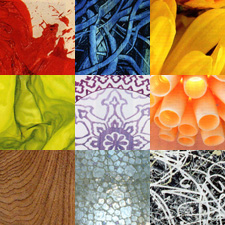Earlier in the year, I received a request from artist/teacher friend Andrea Pumphrey who asked me to give some tips on creating textures. Well Andrea, I’ve rounded up a whole slew of ways to add fabulous textures to your collages! There are so many, I’ve had to turn this response into a series of three instalments beginning with using ready-made textures from magazines.
Collages can be made up of two kinds of surfaces: three-dimensional tactile surfaces (ie. rough, shiny, matte, bumpy, etc.) created with the help of various tools and liquid/gel mediums. If you don’t have these materials handy, you can create the illusion of real-life textures and designs with two-dimensional (flat) imagery found in magazines. Fine Art, Photography, Interior Design, Fashion and Food magazines are great sources for these.
Textures, what are they good for, you may ask? Well, textures give your art that extra oomph. The fine details they reveal can reel viewers into your piece and also give them more information about the world you’re creating and your subject matter. They can also add emotional depth and symbolic significance to your art. If you wish, you can use textures to reveal not only what’s going on on the surface of your work but also what’s underneath it psychologically.
Since my love of textures is inspired by the worlds of film, music and fashion, I can’t but help use a personality from them to assist me in illustrating the role of texture to you. Above is a collage inspired by pop musical video fashionista sensation Lady Gaga. I’m always amazed by the way she uses her body as a canvas for any number of textures to be played out on… leather, vinyl, lace, faux fur, raw meat, synthetic skin, chrome, chain mail, beads, diamonds, gauzy/metallic fabrics, and thinly veiled tattoos all ensure eyes stay riveted on Lady Gaga’s form; they also reveal nasty and brilliant insights into the characters she portrays. Don’t believe me? See for yourself! In her video, “Bad Romance” (warning: scenes may offend some), she uses numerous texture strategies to captivate her audience as well as her unwitting male victim!
So go gaga for textures in your own collages! Not only are they a fun way of adding interest to your collages, they’re a great excuse to recycle your old magazines! Here’s a list of textures to draw from:
Texture List:
– Unusual or decorative metal surfaces (shiny/matte)
– Iron/metals: railings or intricate design work
– Hand woven items: rugs, floor mats, baskets
– Oriental or ethnic hand-made carpets
– Wallpaper from different eras
– Fabric prints with globally inspired patterns
– Fabric with needle work (simple stitches or intricate embroidery)
– Threads/wool/fibre
– Lace, veiled figures
– Patterned or chequered floor tiles
– Ceramics: I love using whole or fragments of hand-decorated objects
– Glass: look for surfaces with shimmer/shine/light/reflections
– Skies: day/night/dawn, clouds, night stars
– Nature: wood grain, sandy or pebbly beaches, watery/reflective surfaces
– Sea stuff: shells, corals, sand, rocks, pebbles, seaweed, fish scales, etc.
– Fur and animal skins
– Clothing from different eras and cultures
– Food: sliced, textured surfaces, glistening, slimy surfaces
– Paintings/drawings/sculptural pieces which reveal finger, brush, pencil or tool marks
– Drawing related: graffiti, “primitive” drawings, calligraphy, mathematic & scientific formulas/diagrams
– Photography: atmospheric/experimental/landscape photos (microscopic/macroscopic), views of space, human body, cells, nature, city and country scapes.
Cut or tear out various sized pieces of textured magazine fragments and integrate them into your collages. Once you’ve collected many you may want to categorize them by subject matter, colour or theme. Place different categories into appropriately labelled boxes or trays so they are easy to locate when you need them. When collaging, think of your textures as a kind of palette to draw from to create colour, dimension, symbolism and more.
Colour/Texture Palette Samples: top left: paint splatter, scraping on canvas, flower petal; middle left: seaweed, carpet design, coral; bottom left: wood grain, glass mosaic tile, graffiti painting
Have you discovered any interesting magazine textures you’d like to share? If so, I’d love to hear from you. Stay tuned for the second installment of my texture series in July when I’ll be covering texture tools from around the house.



This is a great series, and Your collage with Lady Gaga made my jaw drop! Will be back for more, and now you’ve got me thinking about how I can add more textures to my pages. I love your palette samples, I could see it as an entire collection.
Hello Diane! Thanks so much for dropping by. I’m glad you liked the Lady Gaga collage. I’ve never made palette samples like that before…looking at them intrigued me too and opened up a whole new set of design possibilities. Seeing them in little squares like that made me think of the strips of colored papers we often juxtaposed on our pages in Kelly’s journaling classes. It’s neat how depending on the colour and surface texture how the pattern of the image pulls you in or keeps you on the surface. Have a good one! Michelle